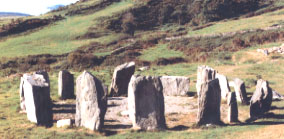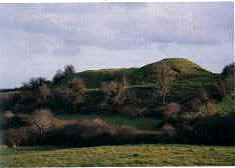| 











|
|
Barrows have been constructed in Ireland since the Middle
Neolithic and were in use until the early centuries A.D. They may cover
or contain megalithic Linkardstown type cists of the Neolithic, all of
the burials type of the Bronze Age (see below) or cremations or inhumations
of the Iron Age. In the east of Ireland the mounds of these these sites
have been levelled in large numbers, leaving Ring-ditches, or have been
remodelled into ceremonial enclosures, as at Tara, or Medieval Mottes
as at Rathmore, Co. Kildare. In the east Ring-ditches have been dates
as late as the seventh century AD. Bowl Barrows, often referred to as
Tumuli or Moats, have a central dome-shaped mound, 2m or higher, usually
enclosed by a fosse and one or more external banks. Where an enclosing
fosse is not noted on the ground it is often found during excavation.
Saucer barrows have low mounds, usually under 1m, and range from 5-20m
in diameter with one or more enclosing fosses and banks. Bell barrows
resemble bowls but have a berm between the mound and the fosse. Ring Barrows
resemble Saucer barrows but have a flat interior rather than a mound.
Another type of barrow has a bank and a hollow interior, these are pond
barrows. Excavation has revealed that a significant number of barrows
belong to the Iron Age (c. 300 BC-100 A.D), but many are of Bronze Age
date as well. The barrows are often found in groups or cemeteries where
a number of types can be found together. Sometimes they are found juxtaposed
to megalithic cemeteries as at Carrowmore, Co. Sligo or associated with
ceremonial enclosures.
Barrows have been constructed in Ireland since the Neolithic,
when they covered megalithic tombs and were in use until the fourth or
fifth centuries A.D. Unlike barrows cairns are a by-product of agricultural
clearance and in upland areas and on thin soils covering exposed geological
formations would have been a readily available building material. Cairns
are usually of three types. High cairns, resembling bowl barrows, which
often covered passage tombs, much lower cairns of less than 2m in height
with flat tops and ring cairns, which enclosed a central burial. A number
of the cairns covering megalithic tombs had Bronze Age cists added to
them or had the central chambers re-used for Bronze Age burial.
These monuments consist of a ring of free-standing
stones, uneven in number and symmetrically arranged so that one stone,
the axial stone, is set directly opposite two stones, usually the tallest,
marking the entrance to the circle. Characteristically, the stones reduce
in height to the axial stone, which is set consistently in the south-western
part of the circle. Though divided into two groups, five-stone and multiple-stone
circles, they are essentially one type of monument with a common basic
design. Though cremated burials in small unmarked pits were discovered
at the three excavated
 |
multiple-stone circles (Bohonagh, Co. Cork, Drombeg,
Co. Cork and Reenascreena South, Co. Cork) these monuments are not
primarily burial places but are generally regarded as ritual sites
where ceremonies took place. Many stone |
circles appear to have been deliberately orientated
so that the main axis of the circle (a line extending from the middle
of the gap between the entrance stones across to the centre of the axial
stone) is aligned north-east/south-west - those sectors of the horizon
in which the sun rises or sets at significant times during the year, an
equinox or solstice. At Drombeg during the midwinter solstice, the sun
appears to set at a point on the horizon in line with the axis of the
stone circle. In Ireland stone circles are concentrated in mid-Ulster
and in South Kerry/West Cork, as are the stone rows. Exact dating evidence
is lacking, but they are likely to be Bronze Age in date.
Fulachta fiadh were an integral component of the Bronze
Age landscape and provide significant evidence of activity in areas with
little evidence of artifact deposition. Usually they consist of horseshoe-shaped
heaps of heat-fractured stone mixed with charcoal and dark soil, associated
with lined rectangular water troughs and hearths. They are also called
burnt mounds and are known from Scotland, Wales, England, Scandinavia
and northern Germany.
Ringforts are the most common site type in Ireland. They
were primarily built and used during the Early Christian period, 500-1200
AD. They are differentiated from cashels in having enclosing banks composed
of dumped earth and sometimes a mixture of earth and stone. However these
distinctions are not clear cut and some sites had earthen banks faced
with stone, or had sections of the enclosing element composed alternately
of earth or stone. In some cases the enclosing element is so eroded or
robbed out and sod covered that it can be difficult to determine if it
had originally been a wall or bank. The distinctions between ringforts
and cashels may be more apparent to archaeologist than the people who
built and used the sites and the choice of enclosing a site with stone
or earth, or a combination of the two may have been determined by the
availability of material, the difficulty of digging a fosse as well as
social concerns of status, manpower and legal restraints.
Cashels were constructed at the same period and fulfilled
the same functions as ringforts. They differ in their construction technique,
being assembled rather than quarried and piled up, and therefore usually
lack an enclosing fosse. The usual technique was usually to construct
two concentric drystone walls of medium-sized blocks and slabs, limestone
was the preferred material, set on a foundation of large boulders. The
are between was then infilled with rubble. The construction technique
allowed for some elaboration and in some case chambers were built into
the walls, sometimes linked to souterrains, and stone steps might lead
to broad wall walks. The walls are often, when well preserved, 2m or higher.
As they represent a ready source of stone may have been plundered to build
field walls, roads and houses. The quarrying and or collection of suitable
stone, its transport and the requirements for skilled wall builders made
a cashel a more expensive alternative to a ringfort and they are much
leass common. They are also restricted to areas where suitable stone was
available. Individuals unable to construct a complete cashel may have
added stone revetments to ringforts to make them resemble cashels. Stone
enclosure at Carrigillihy, Co. Cork was found to date to the Early Bronze
Age and some cashels appear to have been occupied into the medieval period
so that the site type appears to have a long currency.
Souterrains are artificial, subterranean (or semi-subterranean)
structures built to allow access and usually associated with habitation.
They are common in ringforts and cashels of the Early Christian period
c.A.D. 500-1200 A.D and appear to have been used as an underground bolt-hole
if a ringfort was attacked and the simpler examples, without complex chambers
and defensive arrangements such as creeps, were probably also a secure
place to store valuables and perishable foods such as meat, butter or
grain. In a sense the souterrains could represent the most defensive aspect
of a ringfort and it has been suggested that their uneven distribution
may indicate that they were constructed by tribal groupings engaged in
struggles with neighbouring groups. The clustered distribution of souterrains
has been further emphasized by the ongoing work of the Archaeological
Survey. For example no souterrains were noted in any of the 261 enclosures
and ringforts recently published in the inventory of county Carlow.
These rectangular sites, enclosed by water-filled moats
and earthen banks, probably topped by palisades where constructed by the
Anglo-Normans to protect their manor houses. To date the majority of these
sites are known from the south-east of the country, especially Tipperary
and Wexford, and appear to have been constructed along the marches or
border lands of the Anglo-Norman colony and the Gaelic lands. Excavations
have indicated that these sites were constructed and used from the late
thirteenth to the mid fourteenth centuries.
Mottes are flat-topped earthen mounds with a fosse at the
base. Some, but not all sites

The Motte
at Greenmount, Co. Louth. Photo OPW |
have a sub-rectangular area enclosed by a bank and
fosse, known as a bailey, contiguous to the fosse. They were usually
constructed at strategic locations, river crossings or on important
routeways. Sometimes the builders used pre-existing ringforts and
even burial mounds as the bases of these sites. The sites were constructed
by Anglo-Norman lords at an early stage of the Norman conquest in
the thirteenth century. Today they appear as earthworks but they
would originally have been topped woth timber pallisades and are
sometimes referred to |
as timber castles. Most of the examples are found in the
east of Ireland, but there are also examples in the west.
Brindley, A. L. and Kilfeather, A. 1993 Archaeological
Inventory of County Carlow. Dublin, The Stationery Office.
Buckley, V. 1990 Burnt Offerings. Dublin, Wordwell.
Cooney, G. 1983 Megalithic Tombs in their environmental
setting: a settlement perspective, in T. Reeves Smith and F. Hammond (eds)
Landscape Archaeology in Ireland, 179-191. Oxford, British Archaeological
Reports, British Series 116.
Cooney, G. and Grogan, E. 1994 Irish Prehistory: a Social
Perspective. Dublin, Wordwell.
de Valera, R. 1960 The Court Cairns of Ireland, Proc.
Roy. Irish Acad. 60c, 9-140.
Herity, M. 1974. Irish Passage Graves. Dublin.
Herity, M. and Eogan, G. 1977 Ireland in Prehistory.
London, Routledge.
Moore, M. 1996 Archaeological Inventory of County Wexford.
Dublin, The Stationery Office.
Ó Nualláin, S. 1975 "The stone circle complex of Cork and
Kerry", . Roy. Soc. Antiq. Ireland 105, 83-131.
Ó Nualláin, S. 1983, Irish Portal Tombs, topography, siting
and distribution, J. Roy. Soc. Antiq. Ireland 113, 49-57.
Ó Nualláin, S. 1989 Survey of the Megalithic Tombs of
Ireland. Volume V, Sligo. Dublin, The Stationery Office.
O'Kelly, M.J. 1982 Newgrange, Archaeology, Art and Legend.
London, Thames and Hudson.
O'Kelly, M.J. 1989 Early Ireland, an Introduction.
Cambridge, University Press.
Raftery B. 1990 Trackways Through Time. Dublin, Headline
Publishing.
Raftery B. 1990 Pagan Celtic Ireland. London, Thames
and Hudson.
Walsh, P. 1995 Structure and deposition in Irish wedge tombs:
an open and shut case, in J. Waddell and E. Shee Twohig (eds) Ireland
in the Bronze Age. Dublin, Stationery Office, 113-27.
Stout, G. 1991 Embanked enclosures of the Boyne region,
Proc. Roy. Irish Acad. 91c, 245-84.
Sweetman, P.D., Alcock, O. and Moran, B. 1995 Archaeological
Inventory of County Laois. Dublin, The Stationery Office.
Waddell, J. 1990 The Bronze Age Burials of Ireland. Galway,
Officina Typographica, Galway University Press.
|

